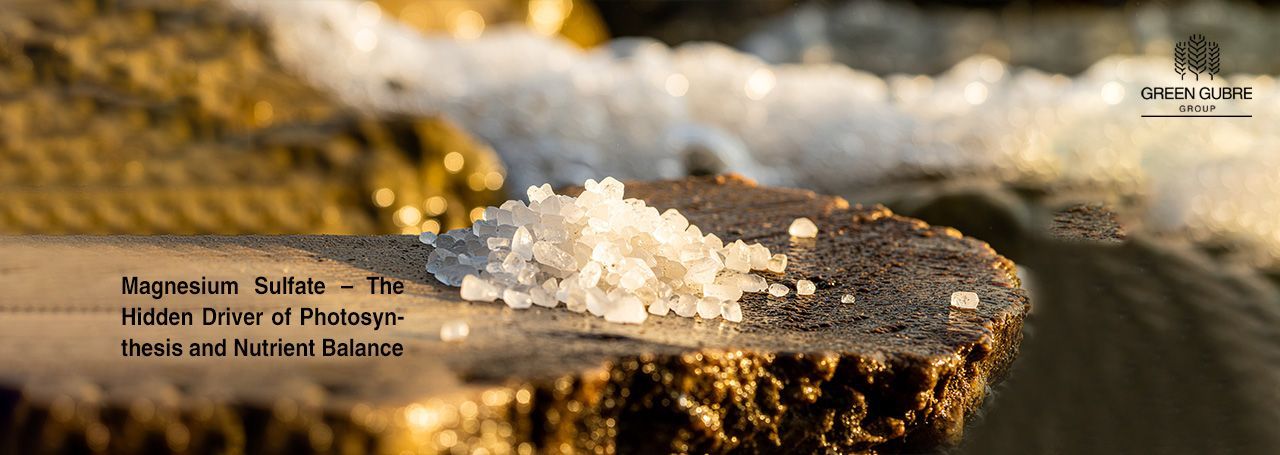Magnesium Sulfate – The Hidden Driver of Photosynthesis and Nutrient Balance
Magnesium Sulfate – The Hidden Driver of Photosynthesis and Nutrient Balance

Introduction: More Than Just a Micronutrient
In the world of fertilizers, macronutrients often steal the spotlight—but magnesium is a quiet powerhouse that deserves serious attention. As the central atom in chlorophyll, magnesium (Mg) is directly responsible for photosynthesis. Without it, plants simply cannot produce energy. Magnesium also plays a key role in enzyme activation, protein synthesis, and the transport of sugars throughout the plant.
Magnesium sulfate—commonly known as Epsom salt in its heptahydrate form (MgSO₄·7H₂O)—delivers both magnesium and sulfur in a highly soluble and readily available form. Whether applied to correct deficiencies or as part of a balanced nutrition plan, it’s an essential tool for high-quality, high-yield production.
What Is Magnesium Sulfate and Why Is It Important?
Magnesium sulfate provides two essential secondary nutrients:
- Magnesium (Mg²⁺): Key for chlorophyll production and enzyme activation
- Sulfur (SO₄²⁻): Crucial for amino acids, vitamins, and oil formation in crops like canola
It’s available in two common forms:
- Heptahydrate (MgSO₄·7H₂O): Crystalline, easy to dissolve, ideal for fertigation and foliar use
- Monohydrate (MgSO₄·H₂O): Higher Mg concentration, used in granular blends
Magnesium sulfate is suitable for:
- Fertigation (drip, pivot)
- Foliar spraying
- Broadcasting as a soluble powder
- Hydroponics
Source – ScienceDirect – Secondary Nutrients in Crop Nutrition
Key Benefits of Magnesium Sulfate
| Benefit | Agronomic Impact |
|---|---|
| Improves Photosynthesis | Mg is the core of chlorophyll—no Mg, no green pigments |
| Boosts Oil and Sugar Content | Sulfur enhances oilseed and sugar crop productivity |
| Enhances Nitrogen Use | Mg helps activate enzymes involved in nitrogen metabolism |
| Reduces Leaf Yellowing | Prevents or corrects interveinal chlorosis in Mg-deficient crops |
| Compatible with Most Inputs | Highly soluble and safe to mix with NPKs and micronutrients |
Field trials have shown that magnesium sulfate improves yield by 5–20% in Magnesium-Deficient soils or during peak crop demand stages, such as flowering and fruiting.
Source – Journal of Plant Nutrition
Ideal Crops and Use Cases
Magnesium sulfate is especially valuable for:
- Tomatoes, Peppers & Cucumbers – For photosynthesis and fruit development
- Potatoes & Carrots – Prevents internal discoloration and hollow tubers
- Citrus & Grapes – Reduces leaf drop and improves juice content
- Leafy Greens – Avoids tip burn and ensures dark green foliage
- Oil Crops (Canola, Sunflower) – Sulfur supports oil synthesis
It is most effective:
- In sandy or acidic soils prone to Mg leaching
- During periods of rapid vegetative growth
- When high NPK fertilization increases Mg demand
Source – Fertilizer Focus Magazine
Application Methods and Best Practices
- Fertigation: Apply 25–50 kg/ha per cycle, depending on crop stage and deficiency level
- Foliar Spray: 2–5% concentration, especially in fruit crops or during stress
- Base Application: Blend into soil before planting in Mg-deficient regions
- Hydroponics: Maintain 25–50 ppm Mg in nutrient solutions
Tip: Always avoid mixing magnesium sulfate with calcium nitrate in stock solutions unless separate tanks are used for each.
Magnesium Deficiency Symptoms
- Interveinal chlorosis (yellowing between veins on older leaves)
- Poor fruit filling or delayed maturity
- Low sugar or oil content
- Increased susceptibility to drought and heat stress
Corrective foliar applications can reverse visible symptoms within days.
Green Gubre Group’s Magnesium Sulfate Offerings
We supply high-purity magnesium sulfate products suited to both smallholder and industrial-scale operations:
- Magnesium Sulfate Heptahydrate (Epsom Salt): 9.6% Mg, 12.9% S, fast-acting and fully water-soluble
- Magnesium Sulfate Monohydrate: 16% Mg, ideal for field blending
- Customized Fertigation Formulas: Combined with micronutrients
- Foliar-Grade Powders: Quick uptake and clean spray solutions
All products are quality-verified, safe for use in fertigation systems, and packaged for extended shelf life.
Conclusion: Unlock the Green Engine of Growth
Magnesium may be a secondary nutrient, but its impact on crop productivity is primary. From photosynthesis to protein formation, magnesium sulfate ensures that plants to grow stronger, greener, and more efficiently. When paired with balanced NPK and sulfur nutrition, it drives performance in everything from vegetables to fruit trees and industrial crops.
Don’t let a silent deficiency limit your yield—feed your crop’s energy engine with magnesium sulfate.




